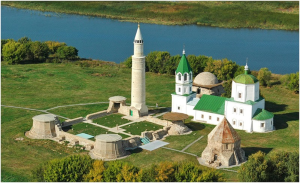Bulgar — the city of Volga-Kama Bulgaria, later — one of the largest cities of the Golden Horde. It is an ancient settlement near the modern town of Bolgarians in Tatarstan. Bulgar was settlede in the X century. Bolgarian historical and archeological complex was declared a World Heritage Site by June 23, 2014.
 Тhe territory of historical and architectural complex is:
Тhe territory of historical and architectural complex is:
-archeologic evidence of the past, which show human presence since the middle of the I millennium BC, an outstanding example of a type of building, architectural and landscape ensemble that illustrates several important periods in the history of mankind, an example arrangement of people and settlement.
— Place the official adoption of Islam Volga Bulgarians — the ancestors of the Kazan Tatars in 922, -Place cult worship, pilgrimage of Muslims to their holy places from the XVI century.
-Place the location of the first capital of the Golden Horde and the minting of the first coins of the Golden Horde.
-Place associated with the presence of eminent personalities here
-One of the first places in the Russian Empire, associated with attention to the problems of conservation and restoration of monuments at the state level
Thanks to the project, we learned more about the history of our native land and were able to imagine how our ancestors lived many centuries ago and realized that Volga Bulgaria alive until we remember about it.
Objectives of the study:
- study of original sources
- study of Internet resources
- the excursion to Bolgar
- consider the different spheres of culture, in which the object is encountered
Content
- Introduction
- World Heritage – Bulgar
2.1. History of Bulgar: from the past to today
2.2. Bulgar in music
2.3. Bulgar in poetry
2.4. Bulgar in art (painting)
2.5. Legends of the Bolgar
- Conclusion
- Bibliography
History of Bulgar: from the past to today
The small town of Bulgar — the administrative center of the Spassky region of Tatarstan, located 140 km from Kazan on the Volga River.
Its history began in 1781, and its present name the city received only in 1991. For two centuries it changed several names: Spassk, Spassk-Tatar, Kuybyshev … It was only in the late XX century, was named after the ancient capital of Volga Bulgaria — Great Bulgar, the ruins of which are very close to the modern town of Bolgar.
Ancient settlement «Great Bulgaria», an area of 550 hectares, is a unique monument of X-XV centuries. Here are preserved samples of the material culture of the Volga Bulgars, the once mighty and prosperous Volga-Kama Bulgaria. Today this place is called the most complete nature reserve the Golden Horde ensemble. Hill fort is open for excursions, you can wander the white stone remains of ancient buildings, imagining how many centuries ago, and there was seething life. The impetus for its creation was the emergence — Aga Bazaar — the most important trading platform of Volga Bulgaria. According to Academician V.L. Ioannina, «all along the eastern end of the trade VIII before the start of the XI century the only gate through which there was a trade with the East, Russia, was actually Bulgar».
On a fairly large area, surrounded by beautiful nature of the Middle Volga are dispersed surviving remains of the chambers, mausoleums and minarets. Under assumptions of archaeologists, the center of the ancient city in Bulgaria has banks of the Volga. Today you can see the Cathedral mosque, remained at the level of the foundation and corner towers.
One of the pillars of the mosque restored — it is called the Pillar Wish not miss the opportunity to make a most intimate, believe me, it will certainly come true.
Next to the mosque — Big minaret — a pastiche stands here before minaret. This minaret was ruined in 1841 because of the passion of people to search for treasure. Dug under the minaret underground passage led to the fact that the oldest building collapsed. Climb the spiral staircase to the top of the minaret, because, according to legend, each step is forgiven sin committed.
The well-preserved North mausoleum holds numerous tombstones from ancient cemeteries — marked with Arabic script and even Turkic runes they are still full of mysteries that scientists have discovered.
Small minaret was built in the XIV century in the image of the Big minaret, but half the height — though smaller copy. Its uniqueness is that until modern times this is hardly the only surviving minaret in Russia Horde era.
Archaeological finds of the ancient Bulgarians gathered in the museum, which opened in the Assumption Church, which is built on the territory of the settlement in the XVIII century on the foundations of the Khan’s palace.
No great city today, but the place of bears` traces of the ancestors of the Volga Tatars, and so revered national shrine. It is a place of Muslim pilgrimage.
Interest in the history of Bulgaria and Bulgar ancient settlement as a monument to the past for the first time was shown as early as the 17th century. Then the order was given to describe the ruins of the ancient city. Since then, attention to the Bulgars unabated. It hosts research; here travelers stop, architects and artists, poets and writers visited Bulgar for inspiration, foreigners — out of curiosity. By the way, Russia’s first decree on the protection of monuments is linked with Bulgars: Emperor Peter I, who visited the remains of the ancient city, ordered to protect its facilities and implement restoration. Today settlement «Volga Bulgars» included in the UNESCO World Heritage List.
Bulgarians plays a huge role in modern humans, as an educational place for all to see. We travelled to Bulgar with our class and found out many interesting things about this unique place. Here, in contrast to the books we were able to not only learn a lot, but also discern historical monuments with our own eyes.